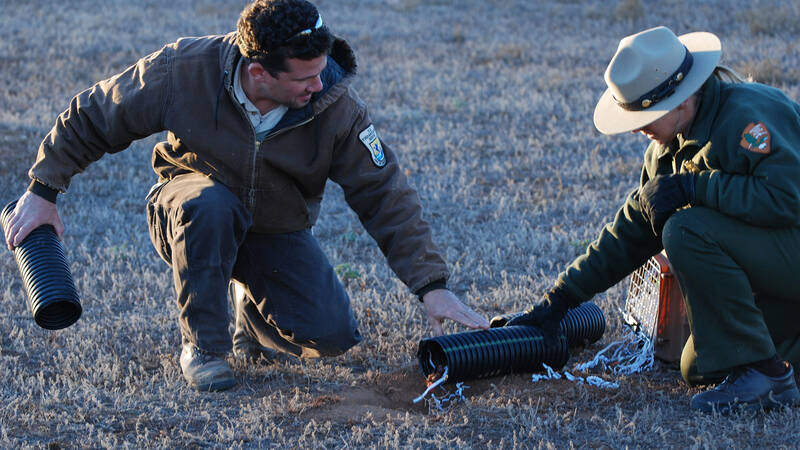The National Park System’s breathtaking landscapes and cultural and historic sites serve as living laboratories for science and discovery that help safeguard our nation’s legacy. Yet today, conservation and research science that support national parks are threatened.
Congress established the National Park System in 1916 with the Organic Act to conserve “the scenery and the natural and historic objects and the wild life therein and to provide for the enjoyment of the same in such manner and by such means as will leave them unimpaired for the enjoyment of future generations.” Conservation isn’t guesswork — it relies on sound science. Only through research, monitoring and data-driven decision-making can we ensure that these irreplaceable resources are being protected unimpaired for future generations.
Recognizing the need for a unified approach, the federal government established the system to manage the 35 national parks and monuments it oversaw in that early part of the 20th century. At its core, the system was meant to ensure that science would guide the stewardship of these protected places — a principle that remains essential today if the National Park System is to fulfill its conservation mandate.
The breathtaking landscapes and historic sites within our National Park System are more than places of wonder and reflection. They are also living laboratories for scientific research and discovery. From tracking wildlife populations to studying water quality to keeping visitors safe, science is essential to understanding and protecting these treasured places.
It is crucial that we keep funding science, because each day researchers learn something new that can help park managers adapt.
Scientists better understand air quality in the Great Smoky Mountains and surrounding areas, for example, because park staff have been monitoring the air for decades — offering a rich understanding of how the environment is changing. Similarly, in Everglades National Park, long-term water quality monitoring has been essential for tracking the health and restoration of this vital ecosystem where water flows and pollutant levels affect wildlife, plant species and underground drinking water supplies for millions of people.
Without crucial scientific data, policymakers and land managers can’t effectively manage the risk of wildfire, make road repairs, keep coastlines from eroding, or properly calculate how many people visit a park and find ways to prevent overcrowding.
Yet today, the role of science in national parks is under threat and is being rapidly eroded in ways that are profoundly harming parks. Recent policies and actions have led to devastating staff losses, freezing of funds critical for scientific research and efforts to keep ecosystems resilient, and the impending closure of vital research hubs and centers.
Without crucial scientific data, policymakers and land managers can’t effectively manage the risk of wildfire, make road repairs, keep coastlines from eroding, or properly calculate how many people visit a park and find ways to prevent overcrowding.
Additionally, important staff in scientific agencies, such as the U.S. Geological Survey (USGS), the U.S. Fish and Wildlife Service (USFWS), and the National Oceanic and Atmospheric Administration (NOAA) have also been let go — agencies with scientists, ecologists and other conservation staff who frequently collaborate with the National Park Service.
By systematically dismantling the scientific infrastructure that supports national parks, the Trump administration’s policies risk leaving parks without the critical knowledge needed to keep our parks healthy — so that air and water stay clean, wildlife can flourish, and climate and environmental changes can be monitored.
Such actions also threaten the well-integrated, centralized system that has effectively coordinated public land management across our country for over a century, the very system that makes the success of individual parks possible.
Some examples of what’s at stake:
- National Park Service scientists, who study wildlife populations, ecosystem health, invasive species and more, have had their research projects indefinitely postponed or abandoned — impacting crucial decision-making processes for park management. Air quality monitoring specialists and technicians are at risk of losing employment or funds necessary to ensure the continuity of collecting samples, which jeopardizes validity of air pollution data.
- USGS, which serves as the impartial science arm of the Department of the Interior, partners with public lands management agencies, such as the National Park Service, on a host of scientific endeavors. These include wildlife recovery and management research, ecosystems and land use, energy and mineral resources, water use and quality, as well as essential data on natural hazards such as earthquakes and landslides in Yellowstone, Yosemite and other parks. Severe funding and staffing reductions delay the agency’s vital land management and safety research.

A U.S Fish and Wildlife Service biologist and a National Park Service ranger release a black-footed ferret into a prairie dog burrow in 2010 as part of the species’ reintroduction at South Dakota’s Wind Cave National Park.
NPSUSFWS offices, responsible for overseeing the collaborative recovery efforts for over 600 threatened and endangered species that call our parks home — such as the black-footed ferret, grizzly bear, red-cockaded woodpecker, several species of salmon and nearly 950 imperiled plant species nationwide — struggle to continue their conservation programs due to staff shortages, budget constraints, and the looming threat of sweeping office closures.
NOAA research centers contribute to the collaborative recovery of threatened and endangered marine species, such as manatees and sea turtles. They also track the effects of climate change on 88 U.S. coastal parks, such as Olympic National Park, and manage vital marine sanctuaries, including the Florida Keys National Marine Sanctuary. Due to slated office closures, staff shortages, funding freezes and budget cuts, these centers may not be able to continue their imperative work conserving marine sanctuaries, completing long-term climate assessments or implementing critical marine habitat conservation plans.
Environmental Protection Agency’s Office of Research and Development informs agency decisions. The proposed gutting of office staff would have major implications for the EPA’s ability to fully function and implement the National Ambient Air Quality Standards (NAAQS) and other programs, such as regional haze initiatives, that rely on quality research and modeling to understand air pollution trends, sources, concentrations and types as well as specific impacts to human health and the environment. National parks receive the highest protection allowed under the 1970 Clean Air Act, a responsibility the National Park Service takes seriously in ensuring parks have the cleanest air in the country — which benefits surrounding communities, as well.
U.S. Forest Service’s ability to manage wildfires; partner with states, Tribes and other federal agencies on wildlife management; maintain public lands, trails and campgrounds; and support rural economies will be significantly strained through staff reductions and decreased funding. There are 76 national park sites bordering national forests. Reduced personnel also limits the agency’s capacity to conduct prescribed burns, respond to emergencies and carry out forest restoration projects. With stagnant funding and rising operational costs, critical programs face delays. The agency also struggles to meet increasing impacts brought about by climate change and recreational use.
- Bureau of Land Management scientists play a critical role in evaluating ecosystem health and identifying areas of critical environmental concern. This month, the Trump administration moved to repeal a 2024 rule that keeps conservation on par with grazing, drilling and other uses of western land. This rollback, coupled with executive orders aimed at boosting energy development and repealing environmental safeguards, undermines the bureau’s legal obligation under the Federal Lands Policy and Management Act to manage lands without permanent impairment to their productivity or environmental quality.
Additionally, the current administration’s push to downsize the federal footprint by selling government buildings and ending leases includes the possible elimination of priceless Park Service research, monitoring and on-the-ground technical expertise centers that support parks around the country. These include a Southeast Utah Group office in Moab that shares staffing and administrative functions at four national parks, and the South Florida Natural Resource Center, which supports long-term efforts to advance restoration of parks across the greater Everglades ecosystem. NPCA remains gravely concerned about these possible closures because of the vital roles that these research hubs, long-term study centers and active monitoring programs play in sustaining and restoring national park sites.
A legacy of scientific discovery
For over 100 years, the National Park Service has gathered data that provides valuable baseline information about the natural world. Our parks have been the seat of pivotal scientific research that has forever changed how we understand our world.
The scientific principle called “ecological succession,” which informs our current understanding of how species respond to ever-changing environmental conditions, was established in the late 1890s at what is now Indiana Dunes National Park. And not until scientists began documenting mammals at Yosemite National Park in the early 1900s, did they begin to understand how species interacted with their environment and therefore had specific roles within that ecosystem — a fundamental principle known as the “ecological niche.” Since 1958, Isle Royale National Park has hosted the world’s longest running scientific study of predator-prey dynamics — research focused on interactions between wolves and moose. The results have greatly influenced wildlife management by documenting how changes in animal populations and habits have ripple effects across the ecosystem.

The Monuments Few People See — and Why They Matter
NPCA has been working to defend the public lands under miles of ocean. Here are some of the reasons these hard-to-see places are so special and need protection.
See more ›Likewise, the establishment of Everglades National Park was grounded in science rather than scenery, marking a turning point in conservation history. It was the first park created to protect an ecosystem for its biodiversity and ecological function, thanks to the efforts of ecologists and conservationists who made a compelling case for its preservation.
When politicians undermine science, they erode the long-standing foundation of informed decision-making that has guided national park leadership for generations. Research centers and stations are the heart of park science, driving long-term monitoring, data collection and policy development. Without proper support, critical studies may be delayed or abandoned, leading to devastating consequences such as species loss, habitat destruction, loss of clear skies and clean water, and greater vulnerability to natural disasters.
Weakened science affects everyone
At its core, science is a rigorous process, built on carefully collected data, repeatable methods and thorough peer review. Park staff repeatedly indicate they want sound science in our parks. They don’t want to abandon projects at the whim of the government, because without sound science, they will struggle to implement effective conservation policies, leading to declining biodiversity, increased wildfire risks and worsening climate-related disasters.
This is not just a loss for researchers — weakened science affects everyone. Research conducted in these protected areas informs national and global strategies for tackling environmental challenges, and losing this knowledge jeopardizes public safety, reduces our ability to mitigate climate change, and erodes the cultural and intrinsic environmental values our country holds dear. In many cases, sound science directly supports local economies and livelihoods. Well-managed fisheries sustain tourism and recreation, and advancing Everglades restoration alone is projected to create over 65,000 jobs.
For more than a century, our country has worked to create the best national park system in the world, and it is a remarkable legacy worth protecting. We can’t afford to lose these vital resources to combat environmental threats or to preserve the pristine habitats record-setting numbers of park visitors flock to experience.
Stay On Top of News
Our email newsletter shares the latest on parks.
About the authors
-
 Melissa Abdo, Ph.D. Regional Director, Sun Coast, Sun Coast
Melissa Abdo, Ph.D. Regional Director, Sun Coast, Sun CoastMelissa brings over 20 years of leadership experience to her role as the Sun Coast Regional Director of NPCA.
-
 Ryan Valdez, Ph.D. Senior Director, Conservation Science
Ryan Valdez, Ph.D. Senior Director, Conservation ScienceRyan Valdez serves as Senior Director of Conservation Science for National Parks Conservation Association. He works to integrate multidisciplinary science into NPCA’s national and regional advocacy efforts to protect all 430+ US national park units.
-
General
-
Issues


